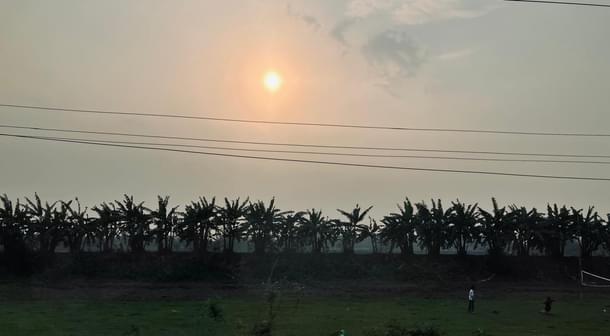Culture
My Journey Into Barpeta’s Doul Utsav — Celebrating Holi In The Vrindavan Of The East
Nabaarun Barooah
Mar 17, 2025, 05:52 PM | Updated 05:52 PM IST
Save & read from anywhere!
Bookmark stories for easy access on any device or the Swarajya app.
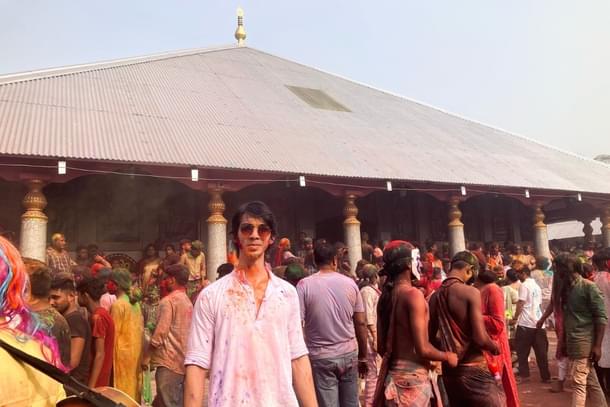
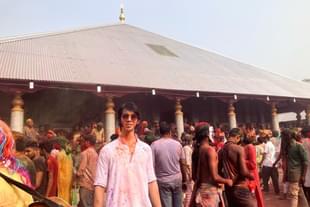
The rhythmic beats of Holigeets echoed in my mind as I set out from Guwahati at 9.30 am, eager to witness the final day of the grand Doul Utsav and Holi at Barpeta.
The city was just beginning to wake up on a lazy Sunday morning, the roads still relatively quiet. As I crossed the majestic Saraighat Bridge, spanning the breadth of the mighty Brahmaputra, I felt a shift in the atmosphere — the journey had truly begun.
Moving into the Bodoland region, I noticed the subtle transformation around me. The shop signboards changed from Assamese to Bodo, an indication of the cultural diversity of the land. Fields of maize stretched endlessly on either side of the road, their golden hue gleaming under the soft morning sun.
The crisp rural air was a refreshing contrast to the bustle of the city I had left behind. The drive, though long, felt effortless, as anticipation built with every passing mile.
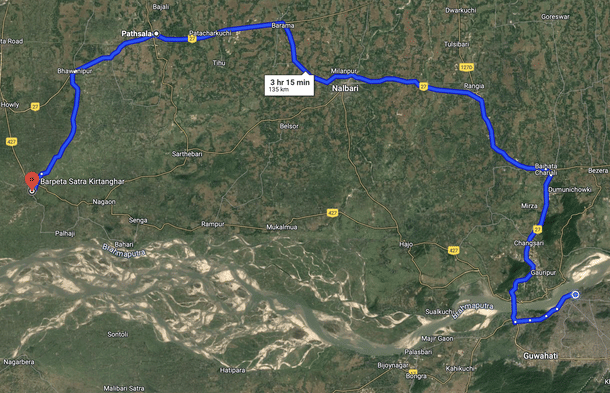
After three hours on the road, I reached Barpeta town. It is one of the last remaining Hindu-majority towns in a Muslim-majority district of Assam.
According to the 2011 Census, the district has a 77.58 per cent Muslim population, largely due to immigration. Back in 1971, when the last wave of immigration from Bangladesh had begun, it was 48.6 per cent. However, the town has a 90.64 per cent Hindu population.
In recent times, there has been alleged encroachment of land, which remains a contentious issue in this landscape of demographic pressures. As such, the celebration of Holi and Doul Utsav becomes an important cultural assertion by the minority Hindu community to mark their own spaces.
On the fourth day of Doul Utsav, the town had been transformed into a spectacle of colours. The names of the shops lining the streets bore a divine touch — Vrindavan Hotel, Kanha Sweets, Murali Handicrafts — each resonating with the spirit of Lord Krishna.
The narrow lanes were filled with people, young and old, reveling in the celebrations. Boys zipped past on motorbikes, their faces smeared with vibrant hues, their laughter echoing through the streets. Women, draped in bright mekhela sadors, gathered in courtyards, their hands stained with gulal as they shared joyous moments with one another.
The air smelled of festivity — floral scents mingling with the sharp, earthy fragrance of colours.
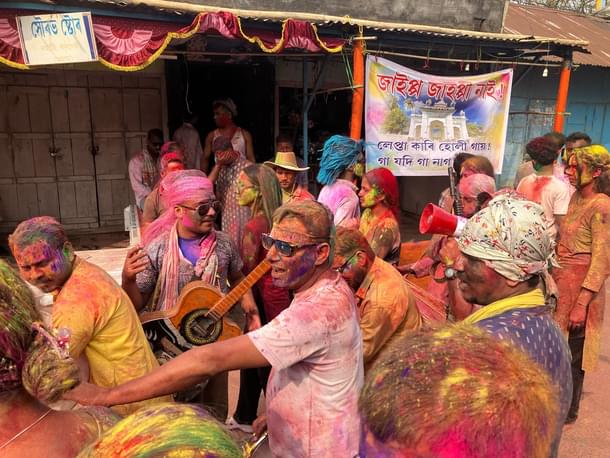
Finding a parking spot was a challenge, but I managed one a short distance away from the Barpeta Satra. The walk to the satra was an experience in itself, the streets alive with bursts of colour as people playfully smeared each other with phakuguri (gulal).
Just before I entered, a group of men approached me with folded hands. One of them, with a kind smile, said, "Thakur, you do not have any colours on you. Can I please put a small tika on your forehead?" Their respect and warmth took me by surprise. I smiled and nodded, and he gently applied the tika before stepping back, joining his hands once again in greeting. "Happy Holi," he said, and I responded in kind.
The revelry was filled with joy, but what struck me the most was the deep sense of respect embedded within the traditions. I saw a man first apply phakuguri to a young girl’s feet before touching her cheeks — a gesture of reverence amid the playful chaos.
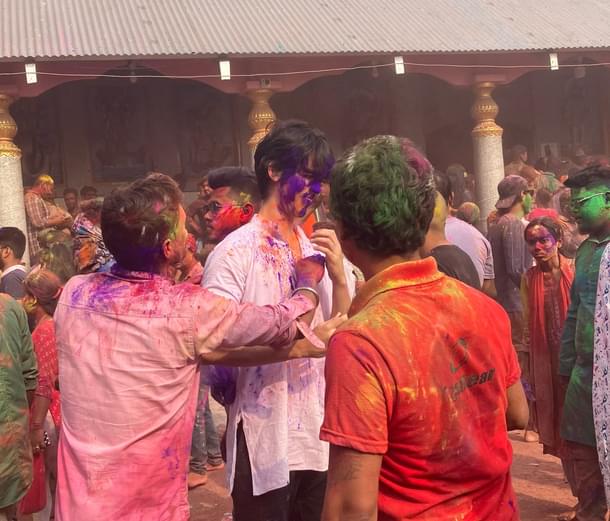
As I stepped into the satra premises, the atmosphere changed. It was electric, yet sacred. The grand open courtyard was brimming with people, all lost in celebration. Some engaged in playful colouring, smearing gulal on friends and family, while others sat in circles, singing Holigeets in unison.
The melodies had an enchanting quality, each note carrying centuries of devotion and tradition. The deep, soulful voices merged with the beats of the khol and taal (musical instruments), creating a mesmerising rhythm that reverberated across the satra.
A Walk Through History: The Barpeta Satra
Upon reaching the Barpeta Satra, I was transported back in time. Established by Sri Sri Madhavdev, the revered disciple of Bhakti saint Mahapurush Srimanta Sankardev, in 1583, this satra is a spiritual epicentre.
It is a monastic institution that functions as a site of congregation and worship in the Ekasarana sect of Vaishnavism. It was here that Sri Mathura Das Burha Ata, the first Satradhikar, laid the foundations of the Doul Utsav.
The festival is modelled by Mahapurush Srimanta Sankardev, who wanted to observe a communal Holi festival after witnessing the fervour of Holi during his pilgrimage to the Braj region. Inspired by this experience, he composed Holigeets in Brajavali, a language blending Assamese idioms with Maithili influences, capturing the essence of Brajbhasha.
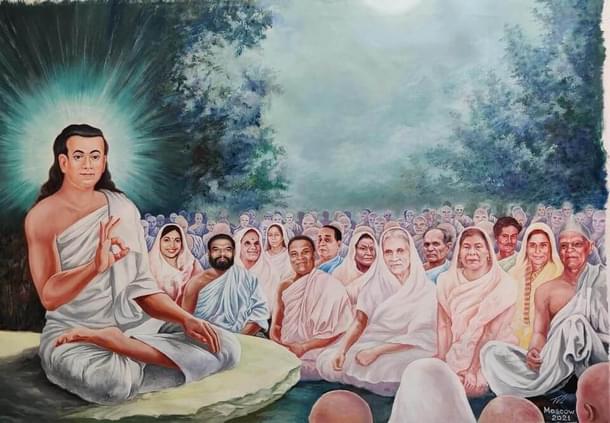
When Sri Sri Madhavdev assigned responsibilities within the Barpeta Satra, Gopal Tanti chose the humble duty of a dasa (cleaner), for he was born in the marginalised community of Candalas.
Pleased with his devotion, Madhavdev renamed him Sri Sri Mathura Das and entrusted him with greater responsibilities, highlighting the egalitarian spirit of Ekasarana Dharma — a Bhakti movement breaking caste barriers.
Mathura Das was also responsible for weaving the iconic Vrindavani Vastra for Koch King Naranarayan at Srimanta Sankardev’s request, a grand textile illustrating Lord Krishna’s childhood in Vrindavan, now displayed at the British Museum.
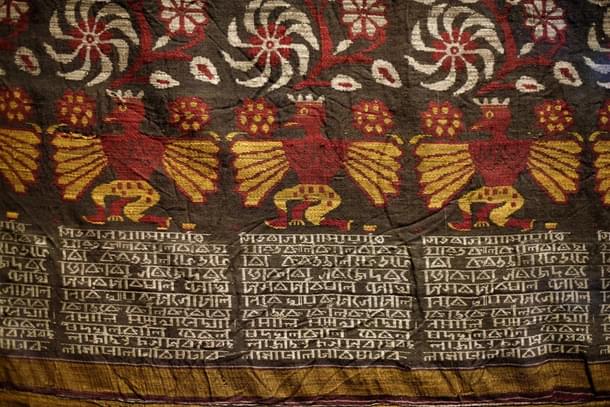
Under Mathura Das Burha Ata’s administration, the satra system flourished, shaping Barpeta into a significant Vaishnavite hub. A democratic governance structure was introduced, a system still in practice today. Followers from all social backgrounds embraced the faith, fostering an inclusive and egalitarian society.
It was at the Barpeta Satra that Mathura Das Burha Ata first celebrated the Doul festival, modelling it after Vaikuntha (heaven; abode of Vishnu), as it was believed that the Doul Utsav was first observed there.
Since then, the Barpeta Satra, often referred to as Ditiya Vaikuntha (second heaven), has upheld this tradition, celebrating the festival with unwavering devotion and grandeur. The Doul Utsav spans four days, marking the Phaguna Purnima (full moon of the Phalguna month).
The first day, Gandha or Banhutsava, is a significant occasion when Vaishnavas construct the Meji (ceremonial fire). As evening falls, Mahaprabhu Doul Govinda and Koliya Thakur (the principal deity of Barpeta; literally: black-skinned god) are brought from the Manikut Ghar (jewel house) to the chotal (courtyard) amid the rhythmic beats of gayan-bayan (traditional music).
The grand spectacle unfolds with the lighting of the Meji (Holika Dahan), followed by Mahaprabhu taking seven rounds around it. The highlight of the night is atachbaji (fireworks), illuminating the sky as people revel in dance and joy.
Following the Holika Dahan, Mahaprabhu is taken to the Jagmohan Ghar (Sabha Ghar for community gatherings). Later, in a sacred midnight ritual, Koliya Thakur is ceremoniously led to the Doul Ghar (a seven-stair building) after circumambulating the seven steps (sapta thak), while the air resonates with Holigeets sung with great devotion.
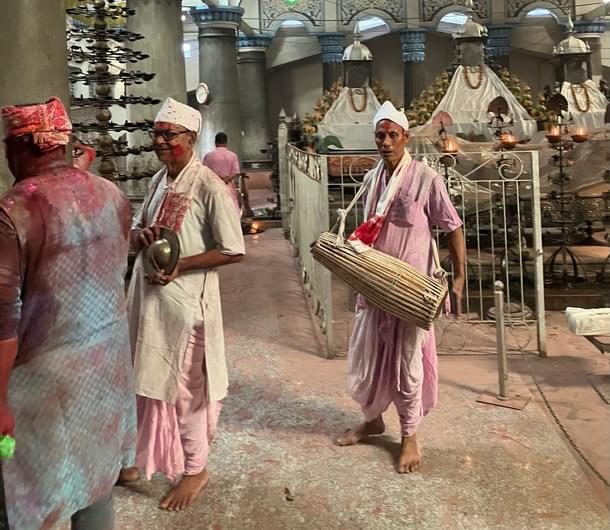
The second day, Bhar Doul, is marked by naam-prasanga (prayer sessions) at the Jagmohan Ghar. After the morning hymns, the day is filled with cultural expressions, including Ojapali (a traditional storytelling dance), gayan-bayan performances, and Dhuliya Nritya (a folk dance unique to the region), making it a mesmerising experience.
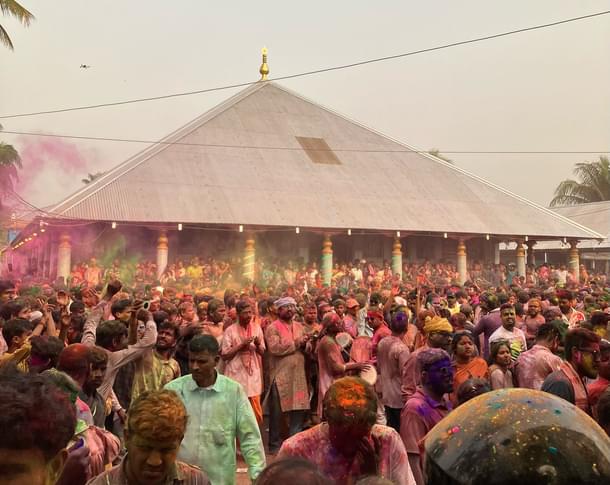
The third day, Phakua, is the most exuberant. In the morning, Mahaprabhu is moved from the Jagmohan Ghar to the Kirtan Ghar, where devotees seek blessings from Koliya Thakur. The town of Barpeta erupts in joy as people play with phakuguri (gulal), immersing themselves in clouds of colour. Holigeets fill the air, reverberating from the ranga mancha (performance stage) and resonating across the town.
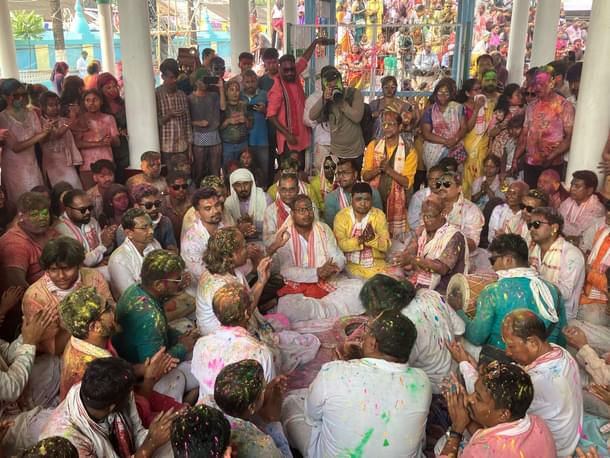
The Black-Skinned God’s Journey
As I stepped foot inside the satra, people had already gathered in thousands to observe the concluding day of the Doul Utsav, also called Suwera.
I made my way to the Kirtan Ghar, where three Asanas (wooden tetrahedral structures with four carved lions) were placed in reverence. It must be noted that since this is a satra operated by kewalia bhakats (celibate monks), women are not allowed to enter the Kirtan Ghar.
The Kirtan Ghar exuded an air of serenity, a stark contrast to the colorful revelry outside. Standing before the Asanas and the lit lamps, I folded my hands in prayer, taking a moment to absorb the sanctity of the space.
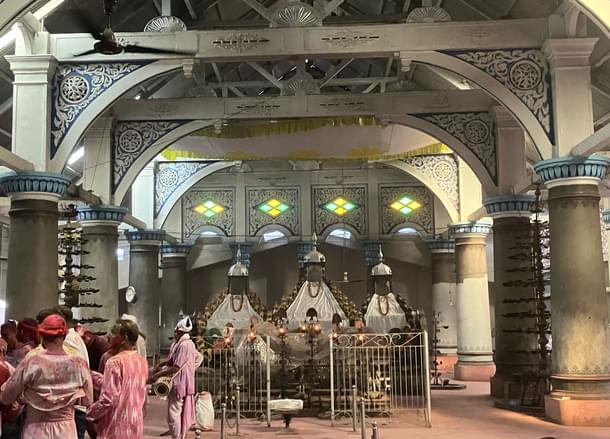
By 3 pm, the excitement reached its peak, as the final jatra (journey) of the Doul began. The idols of Koliya Thakur, Doul Govinda, and Shri Krishna Gosain of the Baradi Satra were placed in beautifully adorned dolas (palanquins) and carried into the chotal.
A wave of jubilation swept through the crowd as phakuguri filled the air, settling like pink mist over the sea of devotees.
The beats of the dhol grew louder, the rhythmic clapping intensified, and the conch shells rang out, signalling the beginning of the grand procession. The atmosphere reverberated with the song, "Anondo diya he, Koila Baba (Give us joy, o Black-Skinned God)."
As the palanquins emerged, the crowd erupted into a frenzy of colours. I found myself swept up in the revelry, my white clothes quickly turning into a canvas of pinks, reds, and yellows.
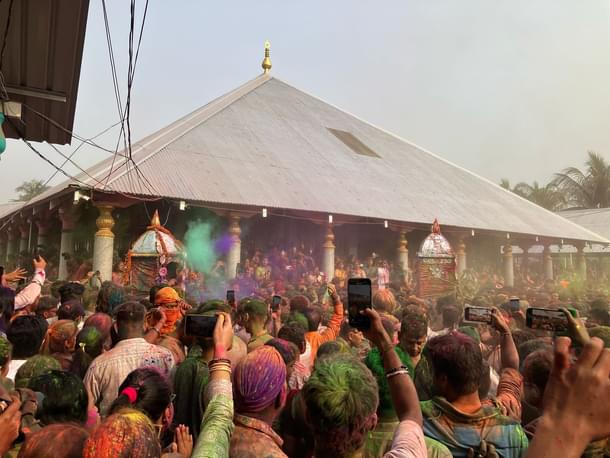
The procession moved towards the Kalbari Satra, guided by a Muslim man in the front, for heketa (feeding of the deity). However, the true climax of the festival awaited us back at the Barpeta Satra.
Upon returning, Koliya Thakur’s entry was halted in a dramatic reenactment of Lakshmi barring Krishna’s way. Four bamboo barriers were erected, preventing the palanquin from advancing. It was an intense yet playful moment, symbolising Krishna’s mischievous nature upon returning to Vrindavan.
The crowd roared as, one by one, the barriers were torn down, each moment marked by an explosion of cheers and colours. When the final bamboo gave way, a surge of energy pulsed through the crowd, a collective exultation that filled the air with unparalleled joy.
Yet, the final step remained. Before Mahaprabhu could enter the Manikut Ghar once again, Bolboloni was enacted, a quarrel between Krishna and Lakshmi, and a symbolic fine of Rs 300 had to be paid — a humorous nod to Krishna’s playful encounters.
The tradition was carried out with great enthusiasm, and as the amount was finally "paid," the grand spectacle reached its conclusion. The three dolas circled in the chotal seven times before the Lord returned to his shrine. The air still thrummed with excitement, the colours of the festival lingering on every surface, every face.
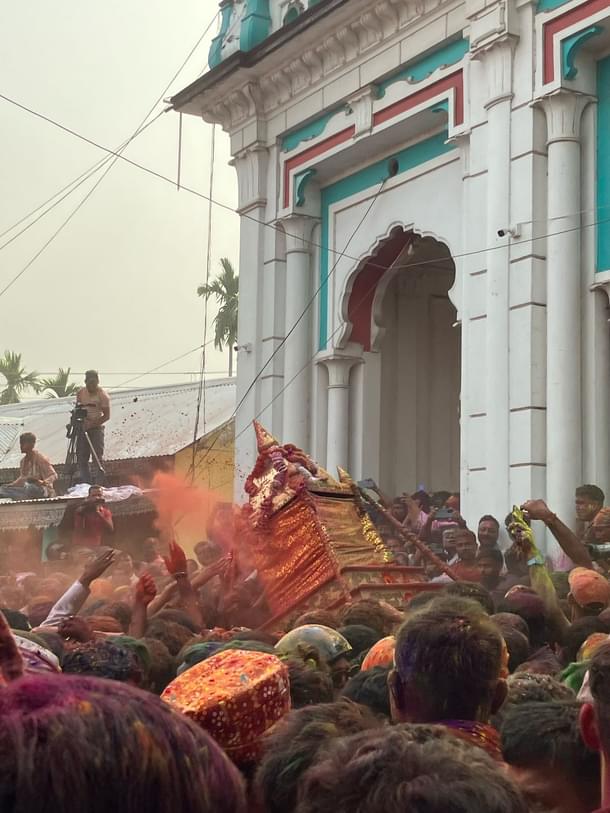
As the evening set in, the sounds of Holigeets continued to fill the air, gradually giving way to a calmer, more reflective energy. The festival had drawn to a close, but its spirit remained.
As I made my way back to my car, I glanced down at my hands, now stained in hues of red, violet, and pink. I knew these colours would fade with time, but the essence of Barpeta’s Doul Utsav would stay with me forever.
Reflections on a Spiritual Sojourn
The drive back to Guwahati was quiet, but my heart was full. And as I crossed the Brahmaputra once again under the evening sky, I found myself immersed in deep reflection, overwhelmed by the sheer magnificence of the Doul Utsav.
Beyond the joyous revelry, Barpeta’s Holi is also an assertion of cultural identity. It is the living testimony of an indigenous minority marking its presence in an ever-changing world, standing resilient in the face of demographic challenges.
More importantly, it is a festival of unity, not exclusion. Despite demographic pressures, Hindus and Muslims both come to celebrate Holi here, dissolving barriers, bridging divides between communities, and retelling history through the lens of love and compassion.
The Barpeta Satra, from its inception, has been more than just a spiritual centre — it has been a beacon of learning, culture, and inclusivity. Rooted in the teachings of Srimanta Sankardev, it has nurtured art, education, and music, preserving the classical traditions of Sattriya dance and Holigeet, ensuring that they remain integral to Assam’s cultural heritage.
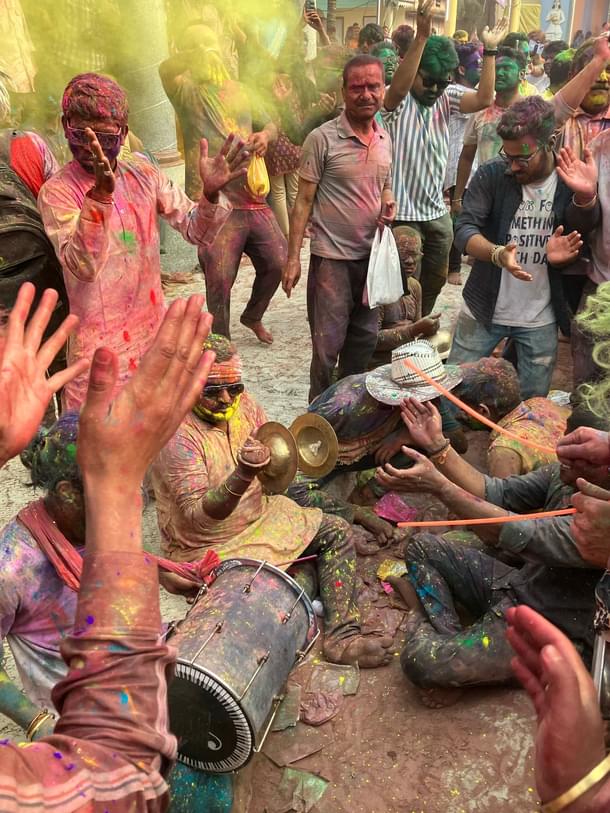
At the heart of this faith lies Ekasarana Dharma, an offset of the Bhakti movement that rejected caste hierarchies and welcomed all with open arms. Even today, the Barpeta Satra continues to uphold this legacy.
Most importantly, Doul Utsav at the Barpeta Satra is not just an Assamese tradition but a reflection of the cultural and spiritual unity that binds India together. Rooted in Sanatana, the eternal, this festival exemplifies how devotion transcends geographical boundaries, connecting Assam with Braj in Uttar Pradesh. This is best reflected in the popular Holigeet:
“Aaji khele Holi range Brindabane; Gopa gopi sabe nache phakur anande (Today Vrindavan is coloured in Holi, and cowherds and Gopis dance to the joy of gulal)."
This cultural synchronicity, spanning diverse regions, highlights the deep interconnectivity of Indian traditions. It stands as a testament to the shared spiritual ethos of the country, where faith, music, and festivity bring people together, dissolving differences and reinforcing the idea of a united India through the universal values of love and devotion.
